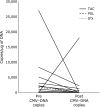Cytomegalovirus infection in ulcerative colitis assessed by quantitative polymerase chain reaction: risk factors and effects of immunosuppressants
- PMID: 30487677
- PMCID: PMC6252306
- DOI: 10.3164/jcbn.18-14
Cytomegalovirus infection in ulcerative colitis assessed by quantitative polymerase chain reaction: risk factors and effects of immunosuppressants
Abstract
We investigated the risk factors of and appropriate treatment for cytomegalovirus colitis in patients with ulcerative colitis, using quantitative polymerase chain reaction analysis to detect cytomegalovirus in the colonic mucosa. Between February 2013 and January 2017, patients with exacerbated ulcerative colitis who were admitted to our hospital were consecutively enrolled in this retrospective, single-center study. Patients were evaluated for cytomegalovirus using serology (antigenemia) and quantitative polymerase chain reaction analyses of the colonic mucosa, which were sampled during colonoscopy. Of 86 patients, 26 (30.2%) had positive quantitative polymerase chain reaction results for cytomegalovirus; only 4 were also positive for antigenemia. The ages of the cytomegalovirus DNA-positive patients were significantly higher than those of negative patients (p = 0.002). The mean endoscopic score of cytomegalovirus DNA-positive patients was significantly higher than that of cytomegalovirus DNA-negative patients. Treatment with combined immunosuppressants was associated with an increased risk of cytomegalovirus. Fourteen of 15 (93.3%) cytomegalovirus DNA-positive patients who were negative for antigenemia showed a clinical response to treatment with additional oral tacrolimus, without ganciclovir. cytomegalovirus reactivation in active ulcerative colitis is associated with age and combined immunosuppressant therapy. Because additional treatment with tacrolimus was effective, patients who are negative for antigenemia and cytomegalovirus DNA-positive colonic mucosa may recover without antiviral therapy.
Keywords: cytomegalovirus; endoscopic features; polymerase chain reaction; tacrolimus; ulcerative colitis.
Conflict of interest statement
No potential conflicts of interest were disclosed.
Figures


Similar articles
-
Effect and safety of granulocyte-monocyte adsorption apheresis for patients with ulcerative colitis positive for cytomegalovirus in comparison with immunosuppressants.Digestion. 2011;84(1):3-9. doi: 10.1159/000321911. Epub 2011 Feb 9. Digestion. 2011. PMID: 21311190
-
Usefulness of quantitative real-time PCR assay for early detection of cytomegalovirus infection in patients with ulcerative colitis refractory to immunosuppressive therapies.Inflamm Bowel Dis. 2007 Dec;13(12):1516-21. doi: 10.1002/ibd.20253. Inflamm Bowel Dis. 2007. PMID: 17828781
-
The association between antigenemia, histology with immunohistochemistry, and mucosal PCR in the diagnosis of ulcerative colitis with concomitant human cytomegalovirus infection.J Gastroenterol. 2023 Jan;58(1):44-52. doi: 10.1007/s00535-022-01931-2. Epub 2022 Oct 26. J Gastroenterol. 2023. PMID: 36287269 Free PMC article.
-
Cytomegalovirus and ulcerative colitis: Place of antiviral therapy.World J Gastroenterol. 2016 Feb 14;22(6):2030-45. doi: 10.3748/wjg.v22.i6.2030. World J Gastroenterol. 2016. PMID: 26877608 Free PMC article. Review.
-
Systemic cytomegalovirus infection complicating ulcerative colitis: a case report and review of the literature.Postgrad Med J. 2004 Apr;80(942):233-5. doi: 10.1136/pgmj.2003.007385. Postgrad Med J. 2004. PMID: 15082847 Free PMC article. Review.
Cited by
-
Risk Factors of Cytomegalovirus Reactivation in Ulcerative Colitis Patients: A Meta-Analysis.Diagnostics (Basel). 2021 Oct 21;11(11):1952. doi: 10.3390/diagnostics11111952. Diagnostics (Basel). 2021. PMID: 34829298 Free PMC article. Review.
-
Cytomegalovirus and Inflammatory Bowel Diseases (IBD) with a Special Focus on the Link with Ulcerative Colitis (UC).Microorganisms. 2020 Jul 20;8(7):1078. doi: 10.3390/microorganisms8071078. Microorganisms. 2020. PMID: 32698383 Free PMC article. Review.
-
Human Cytomegalovirus and Autoimmune Diseases: Where Are We?Viruses. 2021 Feb 8;13(2):260. doi: 10.3390/v13020260. Viruses. 2021. PMID: 33567734 Free PMC article. Review.
-
Cytomegalovirus Pneumonia in Inflammatory Bowel Disease: Literature Review and Clinical Recommendations.Infect Drug Resist. 2023 Sep 13;16:6195-6208. doi: 10.2147/IDR.S420244. eCollection 2023. Infect Drug Resist. 2023. PMID: 37724090 Free PMC article. Review.
-
Characteristics and Clinical Implications of Cytomegalovirus Infection in Patients with Drug-Resistant Ulcerative Colitis Undergoing Colectomy-Data from a Tertiary Referral Center in Poland.J Clin Med. 2025 Jul 8;14(14):4823. doi: 10.3390/jcm14144823. J Clin Med. 2025. PMID: 40725516 Free PMC article.
References
-
- Berk T, Gordon SJ, Choi HY, Cooper HS. Cytomegalovirus infection of the colon: a possible role in exacerbations of inflammatory bowel disease. Am J Gastroenterol. 1985;80:355–360. - PubMed
-
- Papadakis KA, Tung JK, Binder SW, et al. Outcome of cytomegalovirus infections in patients with inflammatory bowel disease. Am J Gastroenterol. 2001;96:2137–2142. - PubMed
-
- Kambham N, Vij R, Cartwright CA, Longacre T. Cytomegalovirus infection in steroid-refractory ulcerative colitis: a case-control study. Am J Surg Pathol. 2004;28:365–373. - PubMed
-
- Cottone M, Pietrosi G, Martorana G, et al. Prevalence of cytomegalovirus infection in severe refractory ulcerative and Crohn’s colitis. Am J Gastroenterol. 2001;96:773–775. - PubMed

